De-Googling TOTP Authenticator Codes – Imrannazar.com
Published on: 2025-09-01
Intelligence Report: De-Googling TOTP Authenticator Codes – Imrannazar.com
1. BLUF (Bottom Line Up Front)
The analysis suggests a medium confidence level in the hypothesis that the movement to de-Google TOTP authenticator codes is primarily driven by privacy concerns and a desire for increased control over personal data. The alternative hypothesis, that this movement is motivated by a broader trend towards open-source solutions and independence from large tech companies, is less supported. It is recommended to monitor the development of alternative authentication tools and their adoption rates to better understand user motivations and potential security implications.
2. Competing Hypotheses
1. **Hypothesis A**: The primary motivation for de-Googling TOTP authenticator codes is privacy concerns and the desire for greater control over personal data.
2. **Hypothesis B**: The movement is part of a broader trend towards open-source solutions and independence from large tech companies.
Using the Analysis of Competing Hypotheses (ACH) 2.0, Hypothesis A is better supported by the evidence, as the source text emphasizes the extraction of data from Google services and the use of command-line tools to manage authentication independently.
3. Key Assumptions and Red Flags
– **Assumptions**: It is assumed that users have the technical capability and motivation to manage authentication codes independently. There is also an assumption that privacy concerns are a primary driver for users.
– **Red Flags**: The complexity of the process described may deter less technically savvy users, suggesting a potential gap between intent and practical adoption.
– **Blind Spots**: The analysis does not account for potential security vulnerabilities in alternative tools or the broader implications of decentralizing authentication management.
4. Implications and Strategic Risks
– **Cybersecurity Risks**: Decentralizing authentication management could introduce vulnerabilities if alternative tools are not as secure as established platforms.
– **Economic Implications**: A shift away from major tech companies could impact their market dominance and influence.
– **Geopolitical Dimensions**: Increased use of open-source tools might lead to regulatory challenges and shifts in digital sovereignty.
5. Recommendations and Outlook
- Monitor the adoption rates of alternative authentication tools to assess the impact on major tech companies.
- Encourage the development of secure, user-friendly open-source authentication solutions to mitigate potential cybersecurity risks.
- Scenario Projections:
- Best Case: Secure and user-friendly alternatives gain traction, enhancing user privacy without compromising security.
- Worst Case: Increased vulnerabilities due to poorly implemented alternatives lead to widespread security breaches.
- Most Likely: Gradual adoption of alternatives with ongoing reliance on major tech companies for mainstream users.
6. Key Individuals and Entities
– Michael Bushey: Mentioned in the context of creating a CLI tool for authentication.
– Vivek Gite: Referenced regarding command-line verification steps.
7. Thematic Tags
national security threats, cybersecurity, privacy, open-source software, tech independence




